STEM Books for Young Readers 2017
By Dianne Timblin
Immersive and inspiring STEM books that make great gifts for young readers
December 20, 2017
Science Culture Art Communications Review Scientists Nightstand
It's that time of year, and once again we're eager to share gift options for all the young book-lovers on your list, from preschoolers through middle schoolers. Most are 2017 releases, but we've included a few titles from late 2016 as well. (You can find our 2016 gift guide here, by the way. And if that's not enough, check out our STEM gift book recommendations from 2015 and 2014.)
It’s been a good year for kids' STEM books and an especially strong one for the life sciences—among others in this category, our suggestions include:
- an atlas of contemporary species (mostly zoological);
- a guide to apex predators, past and present;
- a biography of the naturalist and artist considered the mother of nature education in the United States; and
- a field guide–style introduction to Late-Jurassic era creatures.
It was a great year for kids' books about physics, technology, and engineering too—so read on to find titles for young readers with a range of STEM interests, whether they're into planets, planes, or platypuses.
(If you're looking for books for adult and young adult readers, you can find our latest gift recommendations here.)
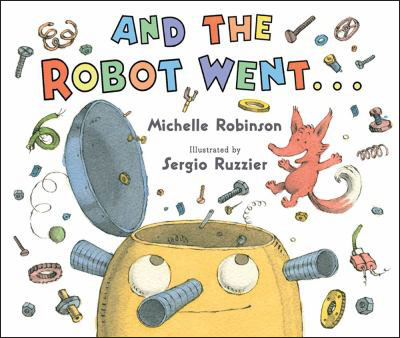
And the Robot Went . . . Written by Michelle Robinson; illustrated by Sergio Ruzzier. Clarion, 2017. $16.99. Ages 4–7.
This fun rhyming tale presents an eclectic community of bears, knights, dogs, and other creatures who, one by one, try to figure out how to get a newly arrived robot working. The story accrues "Twelve Days of Christmas"–style, with each repair attempt getting its moment through a repeating line of verse. At last a young girl comes along, carrying the missing object that puts things right. But the tale doesn't end there, because ultimately it's less about the workings of technology than about a spirit of teamwork among technologists trying to solve a problem. Once the girl has applied her solution, she invites the others to try applying theirs as well. Once all the fixes have been made in order, all is well for our robot hero. The lilting language is great fun, the illustrations are rollicking, and the story's focus on the teamwork behind technology is a refreshing take.
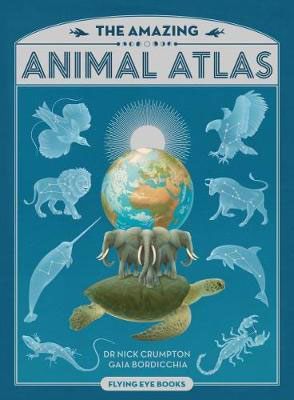
The Amazing Animal Atlas. Written by Nick Crumpton; illustrated by Gaia Bordicchia. Flying Eye, 2017. $28.95. Ages 6 and up.
Gaia Bordicchia's beautiful artwork depicts a vast menagerie of species from all corners of the planet. Amid these wonders, Nick Crumpton supplies key facts about the animals depicted and how marvelously their bodies, habits, and skills are adapted to their habitats. Fold-out pages interspersed through the book provide plenty of room for maps that illustrate where each of these habitats may be found. Finally, a discussion of humans' impact on the environment—as well as actions that can help protect threatened species and support harmonious coexistence—serves as a fitting conclusion.
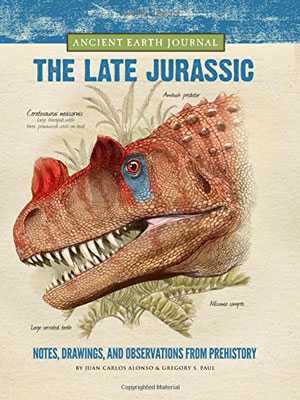
Ancient Earth Journal: The Late Jurassic: Notes, Drawings, and Observations from Prehistory. Written by Juan Carlos Alonso and Gregory S. Paul; illustrated by Juan Carlos Alonso. Quarto, 2016. $19.95. Ages 8 and up.
Presented in the style of a field notebook—with species details typeset to resemble handwriting and straight-edge tracings that mimic writing guidelines—Ancient Earth Journal: The Late Jurassic's design gives readers a sense of experiencing the creatures they encounter in an up-close and personal way. The book's second-person narration reinforces this perspective by placing the reader squarely in the prehistoric landscape. A brief chapter on mammals begins, "It's another typical day in the Late Jurassic, hot and steamy with the constant harassment of biting insects. You escape into the shade of a grove to avoid the sun, and you are surprised to see the trees alive with movement. Jumping from branch to branch, there are several small animals with long tails interacting playfully." Because our understanding of the Late Jurassic can only be pieced together through fossil evidence, the period can seem abstract and unreal. Not so in this title. The authors and illustrator (who also teamed up for the first book in this promising series, 2015's Ancient Earth Journal: The Early Cretaceous) infuse the era with a sense of life and liveliness through vivid narrative, strong storytelling, and detailed, warm-hued illustrations. It makes for a gripping, intimate reading experience.
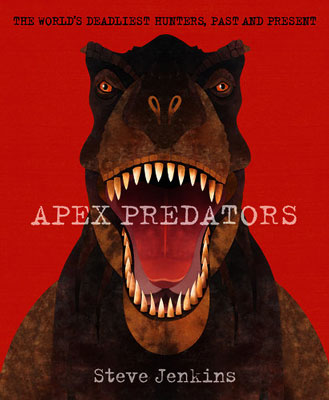
Apex Predators: The World's Deadliest Hunters, Past and Present. Steve Jenkins. Houghton Mifflin Harcourt, 2017. $17.99. Ages 6–9.
This parade of top predators, selected from species that did their carnivorous thing during eras that range from 500 million years ago to the present, is sure to amaze and fascinate. Steve Jenkins starts with a diverse group of contemporary predators: Madagascar's fossa, for instance, which looks like a large, slightly doglike cat but is actually a closer relative to the mongoose, shares a spread with the giant freshwater ray of southeast Asia, an astonishing disc-shaped creature that measures 8 feet in diameter. As the book continues, the reader is taken further and further back in time to learn about a dizzying variety of predators, such as the Titanoboa, a 48-foot water snake that weighed more than a ton; the 8-foot long sea scorpion, one of the very first arthropods; and the giant short-faced bear, which stood 12 feet tall and was fast enough to routinely chase down deer and horses. Jenkins's cut-and-torn paper collages are moody and striking. As the great white shark's spiky teeth and the Utahraptor's saber-sharp "killing claws" make evident, these aren't cuddly creatures—but they are magnificent. The book concludes with a pair of "what-if" face-offs between contemporary and ancient predators, an entertaining twist that should give readers much to think about as they consider other ancient-versus-modern match-ups.
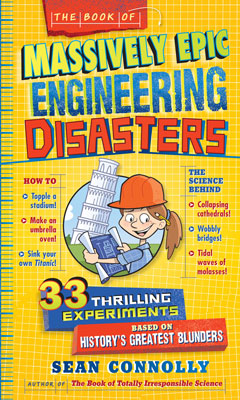
The Book of Massively Epic Engineering Disasters. Sean Connolly. Workman, 2017. $14.95. Ages 9 and up.
Let me begin with a warning. If you obtain this book as a gift and if you intend to give this gift during the fast-approaching holidays, don't crack it open before you wrap it. Seriously, don't—it's better that way. Then you won't feel tempted to read it during every furtive moment between now and the moment, not so far away, when you'll be forking it over to the lucky recipient. Your holiday guests will appreciate the extra hours you'll spend with them, as will your family and friends. Also, the aforementioned lucky recipient won't be puzzled and alarmed by all the coffee-stained and dog-eared pages. In short, this book discusses, describes, and explains 20 structural failures from an engineering perspective. For each, author Sean Connolly builds the story and presents research into how the failure occurred before detailing what went wrong. Each failure is then paired with several experiments involving items that can be found around the house or procured inexpensively at a hardware store. The experiments demonstrate specific principles that builders or engineers either didn't take into account properly or that they simply weren't aware of because the principle involved wasn't yet understood. Some of the tales tell of well-known disasters and failures, such as the sinking of the Titanic and the slant of a certain tower in Pisa. Other, more obscure stories are mind-boggling in their own ways—for example, the Boston molasses flood of 1919. And with that, a final warning: These tales, both the well-known and the obscure, will stay on your mind and may affect your conversations. My husband and I talked about the Hindenburg for at least an hour on the evening when I read that chapter, and that may be an underestimate. So if that's not your jam or your loved ones' jam or the jam of acquaintances or strangers you may happen to encounter while reading this book, remember: You've been warned.
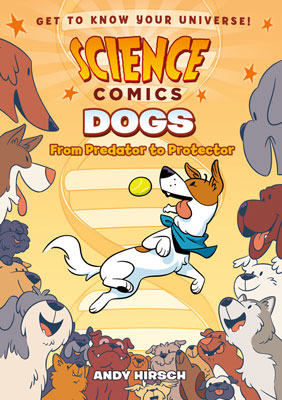
Dogs: From Predator to Protector. Andy Hirsch. Science Comics series. First Second, 2017. $12.99. Ages 9–13.
The folks at First Second, publishers of graphic novels, have kept plenty busy this year. During 2017, they've added four titles to their middle-grade Science Comics series: Bats: Learning to Fly, Flying Machines: How the Wright Brothers Soared, Plagues: The Microscopic Battlefield, and Dogs: From Predator to Protector. Here we're focusing on Dogs, the most recent of these releases, but they're all well worth a look, as are the previous titles in the series. (American Scientist's art director, Barbara Aulicino, wrote about Volcanoes in last year's gift guide, for instance.)
Dogs explores the long and winding natural history of our canine companions, and—despite thousands of years of domesticity—it's a wild and rollicking ride. The story is narrated by an energetic pup named Rudy, who takes time off from his adventures at a dog park to play canine science professor. He discusses the origins and evolution of dogs at some length; embedded in the discussion is a detailed overview of genetics. This portion of the book extends over about 36 pages (of 119 pages overall), an approach that some may consider a bug and others, a feature. Whatever your stance, it includes a nutshell presentation of Darwin's ideas about natural selection as well as a terrific discussion of Dmitri Belyaev's research on domestication, studies that involve selective breeding of silver foxes (Vulpes vulpes). His began the project in Siberia beginning in the 1950s, and it continues today under the direction of Belyaev's protege and research partner Lyudmila Trut, who is depicted participating in the Siberian research but, alas, isn't named. (More on this half-century-plus research project here.) Enlightening sections on dogs' sensory experiences and abilities, adaptability, and behavior follow, all of which is leavened by good humor. (At one point during a discussion about how dogs process language, a bespectacled pug mimics a human. Sporting a giant sweater and waving its forelegs around, the pug exclaims, "Look at me, I'm a human! Words, words, words!") This fun and informative dive into all things canine science may open up whole new avenues of understanding between young readers and their tail-wagging, face-licking, four-pawed friends.

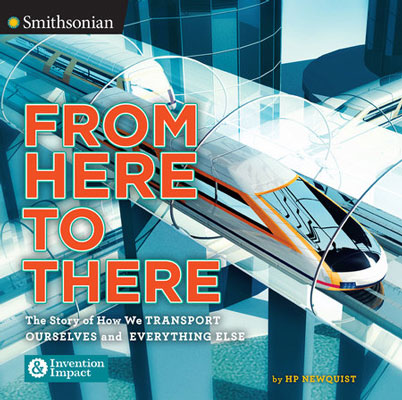
From Here to There: The Story of How We Transport Ourselves and Everything Else. H. P. Newquist. Viking, 2017. $18.99. Ages 10 and up.
Published in collaboration with the Smithsonian and the second in a series called "Invention and Impact," From Here to There transports readers over spans of both time and distance. Although we may no longer think of footwear as a transportation technology, the book's opening chapter makes it clear how important early footwear was for health and safety—whether it was made of animal skins or large leaves wrapped around the foot, sagebrush fibers fashioned into sandals, or, eventually, leather laced securely about the foot. Inventions such as the snowshoe and the ice skate made winter journeying much more practical as well. Chapters on boats, bicycles and motorcycles, automobiles, and air and space travel are packed with interesting information and images. The chapter on train travel is especially rich. A brief concluding chapter looks at new, emerging, and speculative forms of transportation, such as the (erroneously named) hoverboard; drones; flying cars (a niche market, the author concedes); Elon Musk's high-speed mass transit system, the Hyperloop; and teleportation.

Grand Canyon. Jason Chin. Roaring Brook, 2017. $19.99. Ages 7–12.
This excellent primer on the geology and ecology of the Grand Canyon and its many-layered habitats is one of my favorite books of the year. The views it illustrates and the landscape it digs into (scientifically) are breathtakingly clear. The canyon's geologic timeline drives the narrative as a father and daughter take in their surroundings during a hike from the Colorado River all the way up to the canyon's rim, covering about 1.2 billion years of geologic history as they walk the trail. Thoughtful design elements make the book all the more surprising and special. Die-cut "windows" in pages depicting the present-day landscape reveal the origin of a rock formation or fossil the young girl sees, showing the feature on the next spread as it might have looked in the landscape (or seascape) many millions of years before. At the end of the story, as the girl and her father gaze out at the canyon from its rim, spectacular fold-out pages reinforce the scope of the Grand Canyon as we know it today—shaped by myriad geologic changes and home to creatures adapted to its every microclimate and elevation.
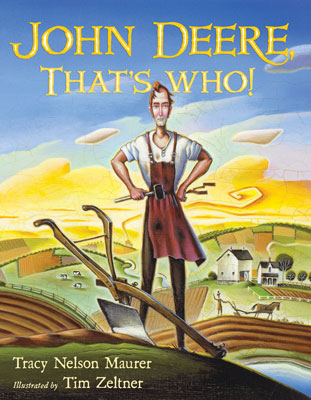
John Deere, That's Who! Written by Tracy Nelson Maurer; illustrated by Tim Zeltner. Henry Holt Books for Young Readers, 2017. $17.99. Ages 4–8.
Spinning a tale more dramatic than one might expect, John Deere, That's Who! tells how Deere designed a better plow, enabling Midwestern farmers in the 1830s to work the rich, sticky soil more efficiently. Deere originally fashioned the new plows from steel saw blades—steel was a significant improvement over the iron used for plows in the Midwest at the time—curving the metal into a shape that would shed soil better than the old designs. The old plows had required farmers to stop frequently to use a wooden paddle to remove clods of soil that would accumulate on the blade; owners of the new steel plows could cut through the soil quickly and cleanly. Deere is a compelling character in Tracy Nelson Maurer's story of agriculture and innovation, struggling to pay off a debt following fires that had destroyed his forge, and then working to save enough money to send for his young family, who had remained back East when Deere set out for the Midwestern frontier, where blacksmith skills were in higher demand. Tim Zeltner's illustrations are fantastic and dreamy, evoking Great Depression–era American agricultural folk art, blended with an introspective style of figure drawing a bit reminiscent of Modigliani portraiture. Despite the compelling narrative and beautiful artwork, however, it should be noted that some might find this depiction of Western migration oversimplified. Don't expect the story to take up the complexities around human and wildlife populations that were displaced as America's Breadbasket was in the making. Still, John Deere is a rousing depiction of how design and engineering, thoughtfully applied to solve specific problems, can improve working conditions and help communities thrive.
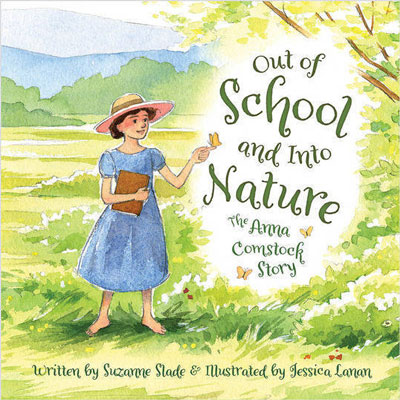
Out of School and Into Nature: The Anna Comstock Story. Written by Suzanne Slade; illustrated by Jessica Lanan. $16.99. Ages 6–10.
In this quiet yet powerful biography, readers learn about Anna Comstock (1854–1930), a woman who became known as the mother of nature education. Her fascination with the natural world began during girlhood as she roved her family's farmland in western New York. In time, this passion guided her to develop her considerable skills as a zoological illustrator, become a naturalist and reference book author and illustrator, and launch a movement to ensure that schoolchildren would learn about the natural world. Author Suzanne Slade supplements the biographical narrative with quotations from Comstock's writings and provides a useful section at the end of the book that delves deeper into Comstock's work and perspective. Jessica Lanan's lovely watercolors make it vividly clear why Comstock's surroundings inspired her so deeply, and Lanan's take on Comstock's woodblock prints of insects help readers see why her artwork was so prized by naturalists.
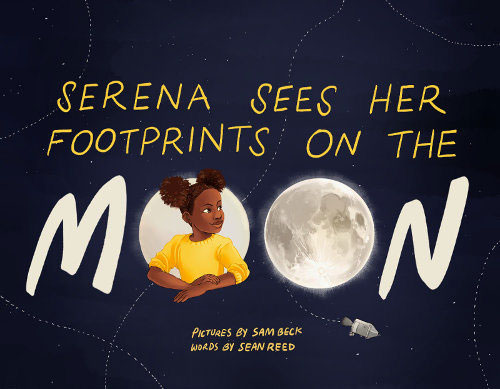
Serena Sees Her Footprints on the Moon. Written by Sean Reed; illustrated by Sam Beck. littleSTEM books, 2016. $12.99. Ages 4–7.
Author Sean Reed's lifelong interest in space, his background in physics, and his time spent teaching high school math students all serve him well as a storyteller focused on young readers. The title character's excitement about space travel is palpable, and it's both thrilling and moving to follow along as she imagines her visit to the Moon so vividly that she knows precisely where she is on the lunar surface. She's also familiar with the array of items that the Apollo astronauts left behind—mirrors, lunar rovers, an olive branch sculpture—and she interacts with these items, hopping into the seat of a lunar rover, for example, and leaving a photo of her own family beside an astronaut's family picture that had been placed on the lunar soil many decades before. Sam Beck's illustrations are a pure delight, capturing Serena's enthusiasm, the Moon's dusty surface, and the odds and ends of Apollo-era space missions with sharpness and panache. Some kids may benefit from a little discussion about the imaginative nature of Serena's journey, especially if they find themselves puzzled over why she's depicted in her everyday Earth clothes, whereas the astronauts she imagines in an early scene are wearing spacesuits. But regardless of whether Serena is transported by her imagination or via spacecraft (which I couldn't help imagining her doing, say, 20 years later), you can't help rooting for her. As the book opens, when she leaves footprints next to those left by Apollo astronauts, I wanted to cheer; by book's close, when she ventures into unexplored territory, leaving her own lone set of footprints for a later astronaut to find, I wanted to whoop, holler, and bring the house down.
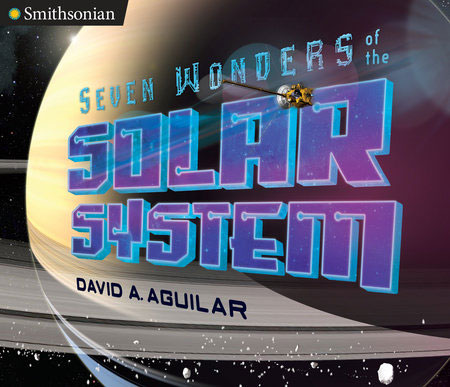
Seven Wonders of the Solar System. David A. Aguilar. Viking, 2017. $18.99. Ages 10 and up.
Written by an astronomer (one who built his own observatory at his home in Colorado, no less) and published in partnership with the Smithsonian Institution, Seven Wonders of the Solar System offers a solidly scientific, narratively vibrant Solar System tour. David A. Aguilar focuses on seven particularly amazing locales and features, ranging from Jupiter's moon Europa, with its vast, ice-covered saltwater ocean, to Saturn's rings (which Aguilar describes as "billions of tons of sparkling ice and rock that form at least eight distinct rings combined into one beautiful system so bright, so wide, it resembles a glittering circular racetrack"), to an elusive giant planet, nicknamed Planet Nine, in the Solar System's outer reaches. A great read as well as a fine introduction—or reintroduction, as the case may be—to our galactic neighborhood.
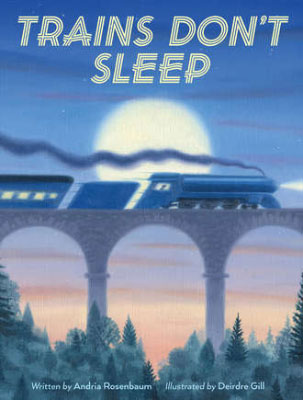
Trains Don't Sleep. Written by Andria Rosenbaum; illustrated by Deirdre Gill. Houghton Mifflin Harcourt, 2017. $16.99. Ages 4–7.
In contrast to its title, this gentle depiction of trains and their role in transporting goods and people is a perfect bedtime read. It showcases earlier eras of rail travel, with a steam locomotive, an old-fashioned circus train, and a sleek modernist-era passenger train each chugging stylishly across the pages. Rhyming verses bring to mind a train's rolling motion and the hypnotic sound of wheels on tracks. The closing pages include a glossary that defines train terminology used in the book that may not be familiar to kids. (Delightfully, it includes a few terms that may be unfamiliar to many adults, too.) Setting the scene in a lush, idealized past makes for a lovely, soothing reading experience, yet it also quietly emphasizes a timeless fascination with trains shared by so many. Observing and studying what they look and sound like, how they're designed and engineered, what they transport, and where they go is enough to fire the imagination, even on the most ordinary days.
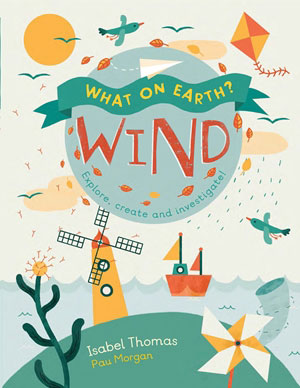
What on Earth? Wind. Written by Isabel Thomas; illustrated by Pau Morgan. Quarto, 2016. $12.95. Ages 6–9.
Vivid cartoon-inspired illustrations accompany text that discusses from all directions the phenomenon of wind. The book opens with two charming poems, followed by the scientific explanation of what causes the breeze to blow. As the story of wind unfolds, the author shares ancient legends about its origins; describes unusual wind conditions around the world; and offers details about how, over time, people have found ways to measure, understand, and predict the wind. The book brims with activities throughout.
American Scientist Comments and Discussion
To discuss our articles or comment on them, please share them and tag American Scientist on social media platforms. Here are links to our profiles on Twitter, Facebook, and LinkedIn.
If we re-share your post, we will moderate comments/discussion following our comments policy.